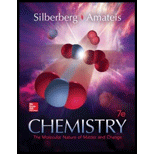
(a)
Interpretation:
The overall reaction and the rate law for each step has to be written.
Concept introduction:
Reaction: Substances which are mutually involved each other in a chemical process and changed into different substances.
Mechanism of a reaction: The representation of step by step process involved in the chemical process is said to be mechanism of a
Elementary step: The first step in a reaction mechanism is said to be elementary step.
Intermediate: Sometimes, in between the reaction some separable amount and useful amount of substances are formed during the reaction and which are said to be intermediates
(b)
Interpretation:
The role of
Concept introduction:
Reaction: Substances which are mutually involved each other in a chemical process and changed into different substances.
Mechanism of a reaction: The representation of step by step process involved in the chemical process is said to be mechanism of a chemical reaction.
Elementary step: The first step in a reaction mechanism is said to be elementary step.
Rate determining step of a reaction: The speed or rate at which the overall the total reaction done and which is slowest step of the chemical reaction.
Want to see the full answer?
Check out a sample textbook solution
Chapter 16 Solutions
Chemistry: The Molecular Nature of Matter and Change - Standalone book
 ChemistryChemistryISBN:9781305957404Author:Steven S. Zumdahl, Susan A. Zumdahl, Donald J. DeCostePublisher:Cengage Learning
ChemistryChemistryISBN:9781305957404Author:Steven S. Zumdahl, Susan A. Zumdahl, Donald J. DeCostePublisher:Cengage Learning ChemistryChemistryISBN:9781259911156Author:Raymond Chang Dr., Jason Overby ProfessorPublisher:McGraw-Hill Education
ChemistryChemistryISBN:9781259911156Author:Raymond Chang Dr., Jason Overby ProfessorPublisher:McGraw-Hill Education Principles of Instrumental AnalysisChemistryISBN:9781305577213Author:Douglas A. Skoog, F. James Holler, Stanley R. CrouchPublisher:Cengage Learning
Principles of Instrumental AnalysisChemistryISBN:9781305577213Author:Douglas A. Skoog, F. James Holler, Stanley R. CrouchPublisher:Cengage Learning Organic ChemistryChemistryISBN:9780078021558Author:Janice Gorzynski Smith Dr.Publisher:McGraw-Hill Education
Organic ChemistryChemistryISBN:9780078021558Author:Janice Gorzynski Smith Dr.Publisher:McGraw-Hill Education Chemistry: Principles and ReactionsChemistryISBN:9781305079373Author:William L. Masterton, Cecile N. HurleyPublisher:Cengage Learning
Chemistry: Principles and ReactionsChemistryISBN:9781305079373Author:William L. Masterton, Cecile N. HurleyPublisher:Cengage Learning Elementary Principles of Chemical Processes, Bind...ChemistryISBN:9781118431221Author:Richard M. Felder, Ronald W. Rousseau, Lisa G. BullardPublisher:WILEY
Elementary Principles of Chemical Processes, Bind...ChemistryISBN:9781118431221Author:Richard M. Felder, Ronald W. Rousseau, Lisa G. BullardPublisher:WILEY





